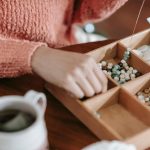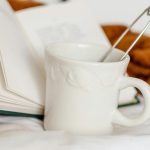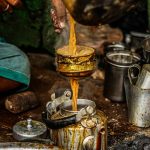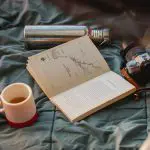When you combine tea staining with other artistic techniques, you can create unique textures and layers that enhance your work. Start by using a strong tea solution on absorbent paper, then think about how to incorporate paints, stencils, or even collage elements. Each layer can transform the overall effect, but you'll want to test your materials first to ensure they harmonize. What you discover in these experiments might surprise you and lead to unforeseen artistic breakthroughs that could redefine your approach. Curious about how to maximize these combinations?
Table of Contents
Key Takeaways
- Experiment with different paper types, as texture and weight can significantly impact the final staining effect and overall appearance of your artwork.
- Layer tea stains with other mediums like paint or collage elements to create rich, textured surfaces and visual contrasts.
- Test color combinations on scrap material before applying them to your final piece to ensure harmony and compatibility.
- Use various application techniques, such as sponging or brushing, to achieve different textures and gradients with your tea stain.
Understanding Tea Staining Basics
Tea staining is a simple and effective technique that adds a warm, vintage look to your artwork or crafts. To get started, you'll need a few basic supplies: tea bags, water, and the material you want to stain. Black tea is the most common choice, but you can experiment with different types for varying shades.
Begin by boiling water and steeping your tea bags for about 10 to 15 minutes. The longer you steep, the darker the solution will become. Once you've reached your desired strength, remove the tea bags and let the liquid cool slightly.
Next, dip your paper or fabric into the tea, ensuring it's fully submerged for an even stain. If you want a more textured look, you can scrunch or twist the material while it's in the tea.
After soaking, take it out and let it dry flat or hang it up, allowing gravity to create beautiful drips and lines.
Choosing the Right Paper
Selecting the right paper can significantly enhance the results of your tea staining project, ensuring that the final look aligns with your creative vision. The type of paper you choose plays a crucial role in how well the tea stain adheres and how vibrant the colors appear.
Here are some factors to consider when choosing your paper:
- Texture: Rough or textured paper can create interesting patterns with tea stains, while smooth paper might yield softer results.
- Weight: Heavier papers absorb stains better, allowing for richer colors, while lighter papers may buckle or warp.
- Acidity: Look for acid-free papers to prevent deterioration over time, preserving the beauty of your artwork.
- Color: Natural or cream-colored paper can enhance the warmth of tea stains, while white paper might create a more stark contrast.
Experimenting with various types will help you discover what works best for your unique style and project goals.
Happy crafting!
Layering Techniques Effectively
When you're layering tea stains, you'll want to think about color harmony to create a cohesive look.
Consider how different textures can enhance your design, adding depth and interest.
Color Harmony Considerations
Achieving color harmony in your tea staining projects requires careful consideration of how different layers interact with each other. When layering techniques, you want to ensure that your colors complement rather than clash. This can elevate your artwork and create a cohesive look.
Here are some tips to keep in mind:
- Choose a dominant color: Start with a primary color that'll set the tone for your project.
- Consider the undertones: Pay attention to the subtle hues in your tea stains; they can significantly affect the overall feel.
- Test combinations: Before committing, do small tests on scrap material to see how colors blend.
- Layer thoughtfully: Use transparent layers to build depth; this will allow the base color to shine through.
Texture Integration Methods
Integrating texture into your tea staining projects can enhance visual interest and create depth, making each layer more impactful. To achieve this, consider using various layering techniques.
Start by applying a base layer of tea stain to your surface, allowing it to dry completely. Once dry, experiment with different textures using materials like sponges, brushes, or even fabric.
For instance, you can use a scrunched-up paper towel to dab additional tea stain onto your piece, creating a mottled effect. If you want to introduce more complexity, try layering contrasting colors. A second layer of a darker or lighter tea stain can dramatically change the texture and tone of your artwork.
Don't hesitate to combine techniques—like embossing or stenciling—to add even more depth. When using stencils, apply the tea stain over the stencil, allowing the underlying texture to peek through.
Integrating Tea Stain With Paint
When you're integrating tea stain with paint, preparing your surface is key for the best results.
You'll want to think about layering techniques and how the colors will work together to create a harmonious look.
Let's explore how to achieve that perfect blend.
Preparing Your Surface
To ensure a smooth application of tea stain and paint, you'll need to start with a clean, sanded surface that allows for better absorption and adhesion. Preparing your surface properly not only enhances the final appearance but also helps the materials bond effectively. Here's how to get started:
Clean the Surface: Remove dust, dirt, and grease with a damp cloth or mild cleaner.
Sand the Area: Use fine-grit sandpaper to create a smooth texture, which helps the stain and paint adhere.
Check for Imperfections: Fill in any cracks or holes with wood filler and sand it down once it's dry.
Wipe Down Again: After sanding, wipe the surface with a damp cloth to eliminate any dust particles.
Test Compatibility: If you're unsure about how the tea stain and paint will react, do a small test patch first.
Layering Techniques Effectively
Layering tea stain with paint can create stunning depth and character in your project. To start, choose a tea stain that complements your paint color.
After preparing your surface, apply your tea stain first. This base layer adds richness and texture, enhancing the overall aesthetic. Use a brush or sponge to apply the stain evenly, ensuring you cover all areas.
Once the tea stain is dry, you can introduce your paint. Opt for a light, complementary shade that allows the tea stain to peek through. When applying your paint, consider using a dry brush technique or even a sponge to achieve a softer, more blended look. This approach helps maintain the visibility of the tea stain while adding layers of color.
If you want to create more dimension, you can use a glazing technique after your paint has dried. This involves applying a translucent layer of paint over your base color, allowing the tea stain to show through.
Experiment with various applications; thin washes or thicker layers can yield different effects. Just remember to work in small sections to maintain control and achieve a cohesive finish.
Color Harmony Considerations
Achieving color harmony is crucial for a cohesive look when integrating tea stain with paint in your projects. When you combine these techniques, you'll want to ensure that the colors complement each other rather than clash. Here are some tips to help you achieve that harmonious balance:
- Choose a Color Palette: Select a palette that includes both your tea stain and paint colors. This will help guide your choices.
- Test Combinations: Always test a small area before committing to larger sections. This way, you can see how they interact in real lighting.
- Consider Undertones: Pay attention to the undertones in your tea stain and paint. Warm stains work well with warm paints, while cool stains pair better with cool hues.
- Layering Technique: Experiment with layering your tea stain over painted surfaces. This can create depth and interest while keeping the color scheme cohesive.
Enhancing Textures With Staining
Tea staining can transform ordinary materials into rich, textured surfaces that captivate the eye and invite touch. To enhance textures, start by selecting your base material—paper, fabric, or wood works beautifully.
First, prepare your tea solution by brewing strong tea and allowing it to cool. The longer you steep, the darker the stain will be.
Next, apply the tea using various techniques. For a subtle gradient, dip your material into the solution and lift it out slowly. For more pronounced textures, use a brush or sponge to apply the stain, varying the pressure to create depth. You can even experiment with layering different tea strengths for a more complex look.
Don't shy away from adding other elements, like wax or pastels, after staining to further enhance textures. These materials can create a tactile experience, making your piece even more engaging.
Combining Collage and Tea Stain
Combining collage elements with tea staining creates a unique visual narrative that adds depth and character to your artwork. This fusion allows you to explore textures and colors, transforming simple materials into captivating pieces.
Here are some tips to help you get started:
- Choose the Right Paper: Opt for absorbent papers like watercolor or mixed media to enhance the staining effect.
- Layer Wisely: Start with a base layer of tea stain before adding collage elements. This way, the stain can seep into the paper and create a cohesive background.
- Experiment with Placement: Try overlapping your collage pieces with stained areas. This can create interesting contrasts and visual dynamics.
- Incorporate Natural Elements: Pressed flowers or leaves can be stained alongside your paper, adding both texture and organic beauty.
Experimenting With Mixed Media
Exploring mixed media opens up a world of creative possibilities, allowing you to blend various materials and techniques for stunning results.
When you combine tea staining with other media, you can create unique textures and effects that elevate your artwork. Start by experimenting with different papers—try watercolor, scrapbook, or even fabric. Each type will absorb the tea differently, giving you diverse results.
Next, consider incorporating paints or inks. Once your tea stain dries, layer on acrylics or watercolors to enhance your piece. You might find that the warm tones of the tea complement the colors beautifully.
Don't shy away from adding stencils or stamps; they can introduce interesting patterns without overpowering your tea stain. You can also mix in other elements like dried flowers, lace, or found objects. These additions can add depth and dimension to your work.
Remember to balance the visual weight of these elements with the softness of the tea stain. Keep experimenting; let your intuition guide you, and watch how your mixed media pieces evolve into something truly original. The only limit is your imagination!
Frequently Asked Questions
Can I Use Herbal Tea for Staining Instead of Black Tea?
Yes, you can use herbal tea for staining. While it may produce different colors and effects compared to black tea, experimenting with various herbal teas can yield unique and beautiful results in your projects.
How Do I Seal Tea-Stained Artwork for Longevity?
To seal your tea-stained artwork for longevity, you can use a clear acrylic spray or varnish. Apply several light coats, allowing each to dry completely, ensuring you protect the delicate colors from fading or smudging.
What Are the Best Tools for Applying Tea Stains?
To apply tea stains effectively, you'll want a few essential tools: soft brushes for precision, sponges for texture, and spray bottles for even application. Experiment with different tools to discover what works best for your artwork.
Can Tea Staining Be Done on Fabric?
Yes, you can definitely do tea staining on fabric! It's a simple process that adds a unique, vintage look. Just soak the fabric in brewed tea, let it dry, and enjoy your beautiful results.
How Can I Remove Tea Stains if I Make a Mistake?
If you make a mistake with tea stains, act quickly. Blot the area with cold water, then apply a mixture of dish soap and vinegar. Rinse thoroughly, and repeat until the stain fades completely.
- Guipure Lace Explained: Everything You Need to Know About This Unique Fabric - June 25, 2025
- What Is Guipure Lace? a Complete Guide to the ‘Netless’ Lace - June 25, 2025
- Natural Fiber Jewelry: Crafting Necklaces With Abaca - June 25, 2025







